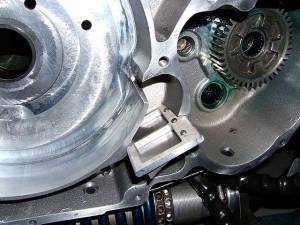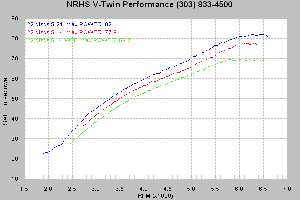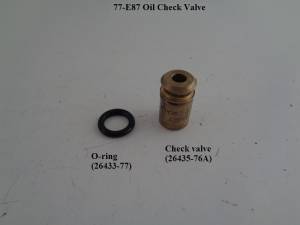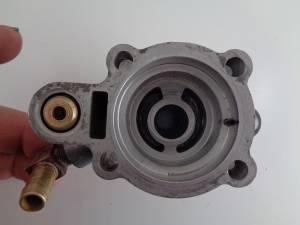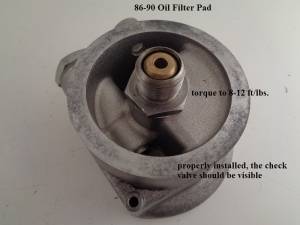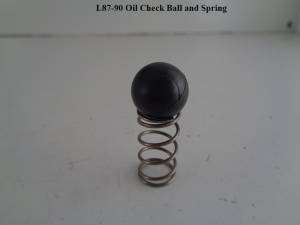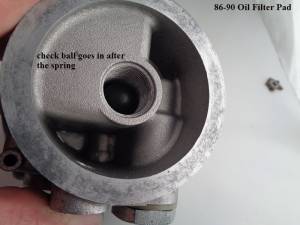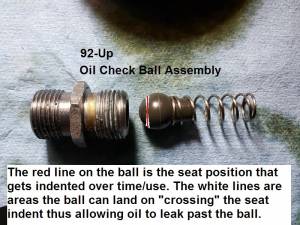Table of Contents
REF: Oiling & Lubrication
Wet Sumping
See also in the REF section of the Sportsterpedia:
- Oil Tank Pressure (see Oil Tank's Role vs Wetsumping on that page)
Wet sumping is a condition between the crankcase and the scavenge passage.
Oil collects in the bottom (sump) area the crankshaft when the oil is not scavenged out fast enough (or during extended shutdown periods)
When the oil balance between feed and scavenge is correct, there should be very little oil gathering in the sump during operation.
However, the sump should not be dry during operation.
A dry sump system simply means the oil supply is not stored in the crankcase as does V-8's.
Instead, the oil supply is stored in the external tank.
During wet sumping, sump oil is churned by the flywheels, air attaches to it leaving (not all but) some of it in the sump longer.
Oil drags the wheels, heat rises and this affects crankcase pressure balance and also adds more drag on engine parts to increase engine wear.
It can be compared to walking along the beach. 1)
If you reach ankle-deep water, it is still fairly easy to move (equivalent to running torque).
However, if the tide comes in or you venture out into deeper water, it becomes much more difficult to walk.
This requires you to work harder and causes you to tire out quicker.
The same thing happens to a machine when the lubricant level is too high. It works much harder pushing thru the added oil.
How sumped oil plays into engine breathing is it allows more oil in the sump to be picked up and slung out the breather vent.
If there wasn't much oil in the sump and the breather vent fails, you get less oil out the A/C even though engine breathing was compromised.
It's a balance. But even then, normal splash oil would be seen out the breather.
It can be attributed to inhibiting crank rotation until the excess oil is returned to the oil tank by the scavenge side of the oil pump.
In extreme cases, it can also be attributed to engine wear, i.e. racing applications.
This can and most likely will happen at one point or another in stock as well as performance engines.
Acceleration is hampered until the oil clears the crank area.
Engine oil sumping can be broken down into two catagories.
1. Wet sumping.
2. Sit sumping (see below or click here ).
Known causes of wet sumping during engine operation:
- Oil Line(s):
- An oil may be pinched / collapsed, or stopped up.
A blockage in the return line will not allow the scavenge pump to remove the oil from the sump or move it out fast enough to keep up with feed oil from the pump. - On ironhead engines with the oil filter in the return line, a stopped up oil filter can hinder adequate oil flow out of the engine.
- A blockage in the vent line from the oil tank to the cam chest can prevent proper oil return pressure from going to the oil tank.
- 86-91 engine oil pressure regulator:
- The discharge from the relief valve drains down into the gearcase.
Then that 'extra' oil and is routed to the crankcase sump through a hole in the case wall and gets pumped back to the tank.
The 'extra' oil adds volume to the sump, thus adds towards a wet sumping condition.
A weak spring or a bad seat at the plunger will cause the regulator to open more often and / or unnecessarily increasing the possibility of wet sumping while riding.
| 1986-90 Oil Filter Mount 2) |
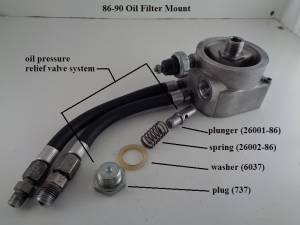 |
Is your Engine Wet Sumping?
Common red flags include:
Click here to read Why Oil Pukes Out the Breather in the Sportsterpedia.
- Blowing oil out the vent/air cleaner during riding first looks to the oil tank being overfilled.
- If the engine is not at operating temp before checking the oil level, you'll end up adding too much oil to the system.
- Oil puking out the breather(s):
- Over extended storage periods (winter or down for repairs), oil from the tank drains slowly down into the crankcase.
When you start the engine, the excess oil in the crankcase can be fired out the breather vent(s) and onto the bike / floor.
See also Evo Crankcase Pressure and Engine Breathing
- Lower oil level in the oil tank over various periods of down time.
See also Overfilling the Oil Tank- The amount of oil (when parked) was correct.
Upon later inspection, the tank may be 1-2 quarts low on the stick.
NEVER check the oil level without first running the engine up to operating temp.
This allows the oil pump to return most of the oil in the sump back to the oil tank before checking the level.
- Overfilling the oil tank can increase the possibility of wet sumping:
- If you fill the tank (improperly), this will result in too much oil in the engine.
It can also result in oil blowing out the oil tank cap or breather(s).
- Lower oil level in the tank after a hard ride.
A good way to tell if your engine is wetsumping (during a hard ride) is to check the oil level right after a leisurely ride. 3)
Then go out and thrash the Hell out of the bike, immediately shut the bike off and check the oil level again.
If it is a lot lower, then it is wet sumping. - Oil filter stopped up or restricted (57-85).
- The oil filter on 85< engines is fed from the oil return side of the oil pump.
- A clogged oil filter not allowing oil to return to the oil tank will leave too much oil in the crankcase and cause it to be blown out the breather vent.
- A sudden loss of power while riding.
See Wet Sumping Due to High Revs below.- After some spirited riding and high RPM passing of cages, particularly riding 2up, the power is just not where it should be. 4)
The bike will continue to accelerate, but not at it's normal rate.
- Difficulty turning the engine over when it's hot. 5)
- Just think about trying to push a piston downwards through a pool of oil.
Clearing the Sump of Excess Oil
Related articles in the Sportsterpedia:
………* Performing a Scavenging Oil Change
………* Sportster Drain Plugs Explained
- The oil should stop puking after the engine runs a few minutes and pumps the excess oil back up into the tank.
- (57-76 models only) are equipped with a sump drain plug under the engine case.
This plug (near the seam between the cases) is known for stripped threads or cracks in the case around the plug once removed. - 77 and up models do not have a dedicated sump drain.
There is a drain plug under the engine but it is a rifling hole to connect the sump scavenge hole to the oil pump scavenge galley.
Removing this plug will most likely drain some oil but it will not empty the sump of oil.
The oil runs uphill from the sump area to the oil pump so the elevation doesn't match up to gravity drain the entire sump.
Wet Sumping Due to High Revs
See also Engine and Primary Oil System Modifications in the REF section of the Sportsterpedia.
- Wet sumping occurs when the crankcase fills up with oil. The crank has to turn in an oil bath when it's really designed to run in open air. The crank running thru the oil heats it up and adds lots of bubbles. It also really cuts down on the available power.
- The scavenger pump picks up the oil and sends it to the oil tank. The hotter the oil, and the more air bubbles in the oil, the harder it is for the scavenger pump to move the oil. So, the oil collects in the crankcase even more.
- The symptoms are sudden dwindling of power and the oil fogging out of the (breather) vent. 6)
Simply slowing the rpm can make it quit very quickly.
When shut off immediately during wet sumping, you may check the oil dipstick to find the oil level low or almost dry.
Fire it back up and it should fill the tank almost full again. - When sumping, it may feek like the motor sort of seized up. 7)
When it happens you know it!
Very sluggish, won't pull and higher oil temp. - The '04 and up Sportsters have had the oil return system redesigned. There are several people having heat and oil consumption issues with 883-1200+ conversions and there are stock bikes having heat and oil consumption issues as well. The 883's and 1200's seem to wet sump worse than years before 2004. Even prior to 2004 Sportster engines were known to wet sump badly under high rpm conditions.
- The '04 and up bikes are having issues with the return from the heads to the crankcase. The pressure from the crankcase is forced UP thru the passages and the push rod covers to go out the head breathers. This impedes the oil trying to go down. The oil sits in the head longer collecting more heat and getting thinner. Eventually, the oil pools in the head deep enough to cover the valve seals which are not designed to be submerged in oil. The piston sucks the thinned and hot oil thru the valve seal and guide during the intake stroke causing the engine to burn excessive amounts of oil.
- It is a chain of events that leads to the oil usage symptom. The high heat of the oil also contributes to the problem and that too is caused by the wet sumping. It also will take a bunch of hp on the dyno and on the street as the crank tries to push through solid oil. 8)
- People have noticed that the '04 and up engines are running much hotter after conversions. Deimus came up with a fix in another thread that may improve the oil flow from the heads to the crankcase. The oil stays cooler, the scavenger pump moves more oil and the problem seems to get better.
- He basically blocks off the head breathers, and then vents the crankcase thru the cam box with a check valve to the atmosphere. This makes it easier for the oil to move down the oil passages and the push rod covers, and helps the scavenger pump move the oil because on the down stroke, the pistons then aid the oil moving from the crankcase to the cam box. The check valve makes sure that a small vacuum is kept on the cam box which further aides the whole process. 9)
What are the causes, symptoms and affects of wet sumping? 10)
Wetsumping (at sustained high RPM) is a condition when the oil pump isn't removing the oil as fast as it's feeding it.
If the cam box fills with oil, it comes out the breather and right to your air cleaner. 11)
The foregoing addresses the affects of wetsumping with the engine running.
Later engines are not competition engines. Maybe the earlier Sportsters were, but those days are long gone. 12)
It's been a chronic issue on XL's for years, happens on the 5-speed bikes as well as the 4-speeds and the ironheads.
But often on the head breather models (91-up), you never know like you do on earlier bikes with the breather on the cam box (pre 91).
- Wetsumping can also be attributed to the Density of the air / oil mix in the crankcase. 13)
- The higher the density (not volume) of the fluid (air / oil mix), the more it drags on the rotating parts it contacts.
- As the density increases so does the fluid drag it imposes on the rotating parts (read flywheel assembly).
- This drag robs power. That's why we mess with it, to reduce the power loss.
- Example: If they are the same size (volume), what takes less power?
- Stirring a cup of coffee or stirring a coffee milkshake? It's the one that's less dense.
- So now we know that less drag = more horsepower and the air is the medium that gets the oil out of the cases.
The 'leaner' (less oil in the air), the less the drag (air / oil is less dense). 14)
The late model bikes can easily wet sump if ridden aggressively on the street, however. 15)
And they've been known to wet sump with only 3 back to back dyno pulls.
The results are dramatic when it happens. It is not anything like a barely noticeable loss in performance.
The scavenging gets behind to some degree in a single drag strip run.
Beyond that, about all you can do is lower the oil pressure.
But don't go down that path unless you establish for sure you are wetsumping and other measures won't fix the situation.
Read more here on a Homemade Oil System Bypass for reducing the oil pressure in the REF section of the Sportsterpedia.
This mod will send a small amount of pressure side oil back to the tank instead of into the engine.
aswracing on Rubbermount Wetsumping at High Revs:
It was fairly easy to restrict the oil to the top of the motor without restricting oil to the crank.
With the XR1000 motor (ironhead bottom end) I used to race at Bonneville, I had done several things to make it's oiling system work properly.
Without those things, the motor would just fill with oil every time we ran it hard.
Zippers has, for about forever, offered an oiling system bypass kit.
It bleeds pressure off and sends some of the oil on the pressure side back to the tank, through a special oil tank cap.
Gapless rings in Sportster motors are famous for causing wet sumping.
Remember, the inlet to the scavenge side of the oil pump is in the crankcase.
So positive crankcase pressure aids scavenging.
Negative pressure makes the pump's job harder, because the pump is fighting the crankcase vacuum.
With little to no blow-by and a check valve on the breather system,
(remember, due to the common crankpin 45 degree design, a Harley motor is a variable volume crankcase, unlike most motors)
They have a reed valve isolating the flywheel compartment from the rest of the crankcase.
The oil pump scavenge inlet is on the other side of that reed valve from the pistons.
The result is that the inlet to the pump never sees negative crankcase pressure caused by the pistons moving up.
We have zero, zilch, nada oil system issues with race motors that use S&S cases.
We can run'em as hard as we want, with whatever rings we want, they never wet sump.S&S's Engine Solution for Wet Sumping: 17)
Here's the S&S solution to the wet sumping issue.
See the reed valve?
In that compartment under the reed valve, against the far wall, is the oil pump scavenge inlet.
So the pump inlet is isolated from any negative pressure in the flywheel compartment, as the reed valve closes.
This works 100%.
The oil pump was given a larger scavenge section, and also an inlet inside the cam box.
The cam box drain to the crankcase was also blocked off.
The idea was to put less oil into the crankcase and give more scavenge capacity to the whole system.
It helped, but high rpm race motors still had the problem.
But it was just a change to the pump body to provide more efficient scavenge operation.
Issues still happened.
The very first '04 1250 we ever did, we saw massive wet sumping issues.
I personally dyno tuned the bike.
I'd be working the bike, pulling mid to upper 90's for horsepower, getting it hot, and all of a sudden it would fall on it's face.
I mean, it'd go from 97 hp on one pull to 62 on the next, and you could just tell it was straining.
Let it cool down for 20 minutes, pull it again, it'd be back in the 90's.
When a motor wet sumps, the crank is submerged in oil.
Visualize running a sprint race in knee deep water.
It kills the power.
It also contributes to even higher oil temps.
As circulating oil plays a big part in engine cooling, and with a loss of power, you have to give the bike more throttle to go a given speed.
More throttle = more fuel burned = more heat.
It's kind of a viscious circle.
Notice a trend here? The focus of every change was to improve scavenging.
I'd be dynoing it, getting it good and warm to where it should make it's best numbers, and bam, it'd fall off a cliff.
Not like that first bike, but I'd still drop more than 10hp from one pull to the next with no changes.
I have some info on it on one of these old threads around here, I think I even showed the chart.
But I never revealed what was going on, I figured we'd help customers who ran into it, and let our competitors go figure it out for themselves.
( link to the article with pics in the Sportsterpedia here: oiling system bypass ).
It's similar to the Zipper's kit but simpler, to drop the pressure, and the problem disappeared.
It's been on there so long now I had almost forgotten about it.
Then Dan started telling me about these issues and had me go running up and down the freeway with him the other day.
But I shelved the idea due to liability concerns.
It's really pretty simple though.
You just tee into the pressure side, between the pump and oil filter, and run it back to the scavenge line and tee it in there.
Somewhere in that line you put a small jet.
I think I have a 145 CV jet in mine at the moment.
With a 165, I would see the oil pressure light flicker on at idle with hot oil. With a 145 it stays off.
Well, there were a couple of key changes to the oiling system for the rubber mounts.
And yet the scavenge inlet remains in the flywheel compartment, not isolated from the pressure variations of the variable volume crankcase.
Hotter, thinner oil is harder to scavenge and will contribute to wet sumping issues.
Not sure how this could contribute to the issues but it's a difference, and we sure saw wet sumping issues get a whole lot worse on the rubber mounts.
It came out last year on the Buell Ulysess (it fits Sportsters, too).
Externally it's the same size, but they've increased the size of the scavenge section yet again,
and reduced the size of the pressure section as well, presumably to lower the pressure. Will it address the issue? I'm not sure.
I've put one on one of my bikes, but haven't set up the conditions to prove whether it really helps or not.
Is it the same as the Uly pump or something else yet again?
The Uly pump fits Evo Sportsters as well.
We need to research that I guess.
I can tell you for certain that with my '04, with over 100hp, and the oil pressure lowered with a simple bypass kit,
and to see Dan's bike running 30 degrees hotter in the same conditions despite having lower compression, well, there's got to be a reason.
I'll whip up some pieces, install'em on an engine that I have on my bench right now, and take some pictures.
It's really pretty simple to do, it's just kind of in a tight spot.
It can be done without removing the cam box cover though.
All I had to do on mine was take off the footpeg bracket and I could get in there enough.The green pull is the very next pull after the red pull, with NO changes to the bike in between those two pulls.
The blue is the same bike a week later, after I had made and installed the little oil pressure bypass kit.|
Sit Sumpimg
This is simply oil from the tank draining slowly back down into the crankcase while the bike is parked for any length of time (and common to all 57 and up Sportsters). 19)
The most notable symptom of sit sumping is a loss of oil in the oil tank after the bike sits for a while.
This is where some make the mistake of adding oil to a cold oil tank to get the level between the hashes on the stick.
Adding oil to a cold motor is never a good idea. Click Here for the checking/adding oil page in the Sportsterpedia.
There isn't much oil pressure on the feed side of the oil check with the motor not running.
For example using Mobile 1 V-twin 20w50, app head pressure at the oil pump was calculated to be just less than 1/4 PSI on a 98 1200S.
This figure will change slightly depending on your current altitude above sea level, oil density and height of oil in the tank. But just for argument sake..
And subtracting say 60-70% of that going back up to the oil filter pad leaves very little pressure against the oil check.
Click Here to read more on calculating oil tank head pressure in the Sportsterpedia.
The OEM spring behind the check ball keeps pressure at 4-6 PSI against the ball to it's seat according to the manuals.
And doing the math, there should be less pressure on the incoming side of the check ball than spring seat pressure.
Meaning there shouldn't be enough gravity oil pressure when shut down to overcome the check system.
However, we know oil will leak down into the motor during shut down and for reasons below or more.
When you start the engine, the excess oil in the crankcase can end up being fired out the breather(s), onto the floor, (or into your air-filter on 79-up models).
It doesn't take long for the pump to return the excess oil (drained into the motor) back to the tank, then the oil level is higher there.
Known causes of sit sumping during engine down time:
- Oil Pump:
- Worn / damaged oil pump housing / parts.
- Clearances in the pump can widen over time and allow oil to seep into the motor from the oil tank.
- Worn / damaged seals (or plates respectively). Gravity pressure is always present on the feed side of the pump.
If the seals are compromised, that gravity oil will seep past the gears/gerotors respectively and into the engine.
- Check Ball / Check Valve:
All Sportsters have some sort of an oil check system in place.
The check ball can be thought of as the on / off valve for oil supply into the engine.
On 57-85 engines, the check is in the oil pump and on 86-up engines, the check is in the oil filter pad.
The main objective of the oil check is to keep the oil in the tank from entering the motor during shutdown (and prevent a sit sumped condition).
Occasionally the check gets weak or damaged and allows oil to bypass it or dirt/debris blocks a good seat.
Some oil transfers silently from the tank into the motor.- The 57-76 steel check ball seat in the oil pump body can get dirty and / or pitted from usage and debris.
- The 86-E87 spring (whether check ball or valve) can break or weaken which won't push the unit against the seat properly.
The check cartridge can get clogged with debris and the check ball can develop a ring around the seat that may allow oil to seep past it.
Without adequate seat pressure, oil will bypass into the engine.
- Breather Gear (57-76 engines):
- 57-76 engines can sit sump by way of oil in the gearcase dripping into the crankcase through the window in the breather gear.
If oil gets into the crankcase high enough to reach the transfer valve, it'll spill over into the primary compartment.
Read more about the Transfer Valve in the Sportsterpedia.
- Oil Filter Adapter (1986-up engines): The filter adapter is a 2-way threaded union installed into the filter pad.
- Leaking filter adapter threads. 20)
The threads on the end, that connect to the filter housing (toward the motor), can seep oil into the motor.
The adapter should have Loctite applied to the threads (end that threads into the filter pad) when installed.
The Loctite acts to help keep the adapter from coming loose from vibration as well as to help seal the area between the threads from seeping oil.
If oil migrates between the adapter to housing threads, it can bypass (get behind) the check valve / check ball and into the motor. - Loose filter adapter. 21)
The hex nut in the middle of the adapter should be installed tight against the housing and torque'd to factory spec BEFORE installing the filter.
When removing the filter, the adapter CAN back out a few threads.
(especially if Loctite was either not added when it was last installed or the Loctite came loose somewhat)
In that instance when installing a new filter, the threaded adapter may not tighten back before the thick rubber seal on the filter mates to the filter pad.
The filter will still tighten up as required with no external leaks, but the adapter may be a few threads shy of being tight into the housing.
This would not compress the spring behind the check ball as much, thus resulting in less pressure pushing the ball against it's adapter seat.
And it could allow oil to push against the ball enough to allow oil to pass into the motor.
Or it could allow the spring to lean the ball in a position off of the ring seat indention.
The check valve is spring loaded. Debris can lodge in the spring seat and keep it open.
The spring can also get weak with wear and the cup seat may not sit properly to seal off.
Even the Teflon ball had a design flaw. The ball can have a variance in landing on the seat position depending on forces to and fro. 25)
A small particle of debris may be lodged at the seat position of the check ball keeping the passage open.
The check ball may have rings formed on it at the seat position by the seating action itself over time.
If the ball doesn't fall back on the ringed area every time the engine shuts down, oil will leak into the groove and then the engine.
A check ball that is no longer perfectly round will not sit properly on the round seat and oil will leak past it into the engine.
In the L87 ball below, you can see the joint where it was made. The seal depends on this joint not entering the seat, else you can get an oil leak past the joint.
In the first pic below, you can see a slight ring on the left side where the ball was seating. That ball was definitely seating with the joint touching the seat in spots.
The 92-up Teflon ball does have a “tail” installed into the spring, but that didn't entirely fix the problem.
The longer the ball sits against the adapter, a ring indention can get impressed into the ball where it seats.
The indention on the ball is totally dependent on the angle at which the individual spring rests on a regular basis.
So that ring may be different on another bike depending on how long the ball has been installed and exactly how the individual spring lays at rest.
Used long enough, the indention can “mushroom, per say around the ball.
In that case, the ball SHOULD rest back inside that mushroomed area (which may or may not leak, depending).
But that also may result in the ball getting pushed further toward the filter adapter, lessening spring pressure on the ball.
And the more it mushrooms, the less back tension you'll get from the spring.
Low tension from the spring can result in oil seeping past the ball.
This one on a 2005 Sportster has the ring indention but it has not mushroomed and does seal.
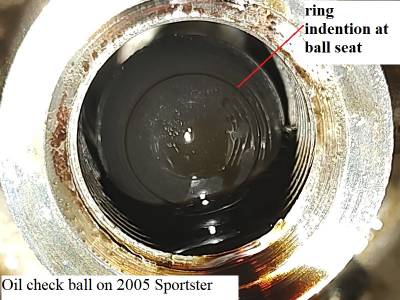 28)
28)

